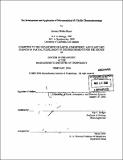| dc.contributor.advisor | Kip V. Hodges. | en_US |
| dc.contributor.author | Boyce, Jeremy Welles | en_US |
| dc.contributor.other | Massachusetts Institute of Technology. Dept. of Earth, Atmospheric, and Planetary Sciences. | en_US |
| dc.date.accessioned | 2007-11-15T19:50:16Z | |
| dc.date.available | 2007-11-15T19:50:16Z | |
| dc.date.copyright | 2006 | en_US |
| dc.date.issued | 2006 | en_US |
| dc.identifier.uri | http://dspace.mit.edu/handle/1721.1/34662 | en_US |
| dc.identifier.uri | http://hdl.handle.net/1721.1/34662 | |
| dc.description | Thesis (Ph. D.)--Massachusetts Institute of Technology, Dept. of Earth, Atmospheric, and Planetary Sciences, 2006. | en_US |
| dc.description | Includes bibliographical references. | en_US |
| dc.description.abstract | The (U-Th)/He thermochronmeter is the foremost tool available to geoscientists for the purposes of constraining the thermal evolution of the crust below 250°C. However, the potential of the technique is far from fully explored. The existing de facto (U-Th)/He age standard, the fluorapatite of Cerro de Mercado (Durango, Mexico), does not yield reproducible dates, an observation confirmed at several laboratories. A series of experiments combining analytical and numerical techniques suggests that variations in U and Th measured in a single sectioned crystal could result in several percent apparent age variation due to unequal alpha recoil exchange across internal zone boundaries. Heterogeneities may also play a role in the variability observed in the diffusive behavior of He in strongly zoned minerals, such as monazite. He diffusion experiments on monazite indicate that the closure temperature for (U-Th)/He thermochronometry is between 206°C and 286°C, but varies from grain to grain, even within suites of crystals obtained from one rock. This may be due to compositional variations in the host monazite. Typically heterogeneous monazite crystals may have different closure temperatures, and single crystals may preserve large portions of the cooling history of a rock. | en_US |
| dc.description.abstract | (cont.) None the less, monazite appears to have great potential for (U-Th)/He chronometry, and because of the high U and Th (and therefore 4He) concentrations observed in many monazites, it is a prime candidate for microanalytical (U-Th)/He. A microanalytical protocol for (U-Th)/He chronometry has been developed by applying the laser microprobe to polished crystals or crystal fragments of monazite. Agreement with conventional (U-Th)/He ages is to within -1.3%, with previously unavailable spatial resolution of -30pm. Large numbers of laser microprobe (U-Th)/He ages can be generated more rapidly than by conventional means, and this technique allows the dating of grains that would not be acceptable for conventional (U-Th)/He. Application of laser microprobe (U-Th)/He to monazites from Nanga Parbat, Pakistan, yields highly reproducible cooling ages within and between single crystals. Mean ages of 0.746 ± 0.049 Ma and 0.753 ± 0.036 Ma from two crystals, and the direct observation of negligible (U-Th)/He age gradients, support minimum mean cooling rates of > 325 K/m.y., and minimum mean rock uplift rates of > 4 km/m.y.. Laser microprobe (U-Th)/He of zircon produces no geologically useful dates, a consequence of the poor U and Th measurements provided by LA-ICPMS. | en_US |
| dc.description.abstract | (cont.) Future efforts should employ better calibrated LA-ICPMS approaches or next-generation electron microprobe techniques, which can provide more accurate U and Th concentrations than LA-ICPMS, even for the low concentrations found in zircon. | en_US |
| dc.description.statementofresponsibility | by Jeremy Welles Boyce. | en_US |
| dc.format.extent | 236 p. | en_US |
| dc.language.iso | eng | en_US |
| dc.publisher | Massachusetts Institute of Technology | en_US |
| dc.rights | M.I.T. theses are protected by copyright. They may be viewed from this source for any purpose, but reproduction or distribution in any format is prohibited without written permission. See provided URL for inquiries about permission. | en_US |
| dc.rights.uri | http://dspace.mit.edu/handle/1721.1/34662 | en_US |
| dc.rights.uri | http://dspace.mit.edu/handle/1721.1/7582 | |
| dc.subject | Earth, Atmospheric, and Planetary Sciences. | en_US |
| dc.title | The development and application of microanalytical (U-Th)/He thermochronology | en_US |
| dc.type | Thesis | en_US |
| dc.description.degree | Ph.D. | en_US |
| dc.contributor.department | Massachusetts Institute of Technology. Department of Earth, Atmospheric, and Planetary Sciences | |
| dc.identifier.oclc | 71195841 | en_US |
